Inscriptions, texts nos. 40-62
Browse the RIAo Corpus [http://oracc.museum.upenn.edu/riao/pager/]
Quick links
Statue from Ashur of Shalmaneser III (no. 40)
Clay cones from Ashur and Tell Hawa (nos. 41-46)
Various inscriptions from Ashur (nos. 47-55)
Fort Shalmaneser's Throne Base (Room T1) - Epigraphs (nos. 57, 59-62)
40 41 42 43 44 45 46 47 48 49 50 51 52 53 54 55 56 57 58 59-62 60 61 62
40
A statue of Shalmaneser III was found broken in pieces at the entrance to a Parthian building at Ashur, during the German expedition in 1903. Afterwards, the monument had been repaired and displayed in the Archaeological Museum of Istanbul. Its high must have been about 250 cm and its original location was most probably the Tabira Gate, as stated in the inscription engraved on it.
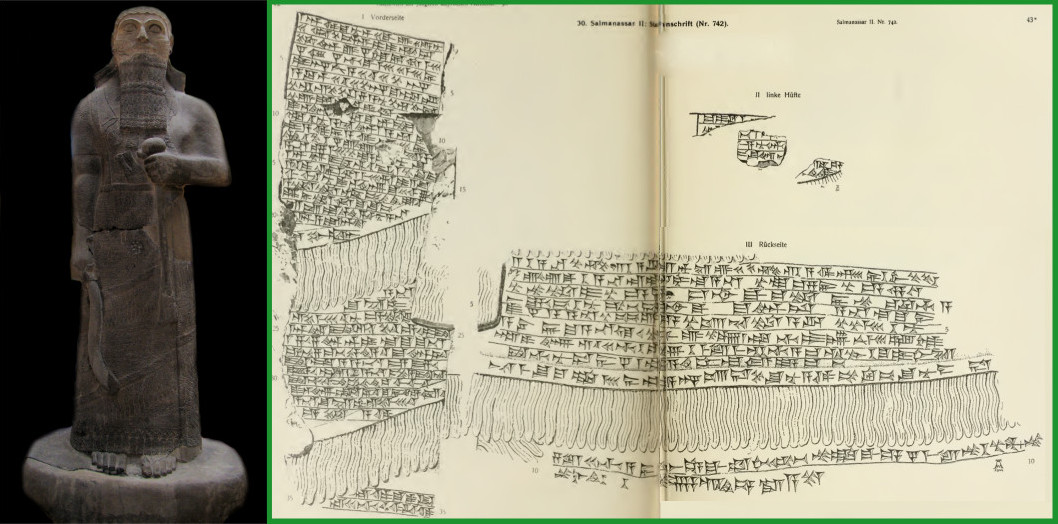
Ist EŞEM 04650. Elaboration with KAH 1, 30
Statue and inscription were created to commemorate the restoration of the inner and outer walls of Ashur (ll. iii 9-11). It has a nine-lines introduction that includes the kiong's name, his epithets and a general overview of conquests. The text continues with a non-chronological record of several campaigns. The maned years of reign are: the fourth (855 BC; ll. i 10-13), the sixth (853; ll- i 14-24), the eighteenth (841; ll. i 25-ii 1), an unknown year (ll. ii 2-6), the twenty-fourth (835; ll. iii 1), the twenty-second (837; ll. iii 2-4), and the twenty-sixth (833; ll. 5-8; dating the inscription). No concluding blessing or curses are present.
Access the composite text [http://oracc.museum.upenn.edu/riao/Q004645/] of Shalmaneser III 40.
Bibliography
41
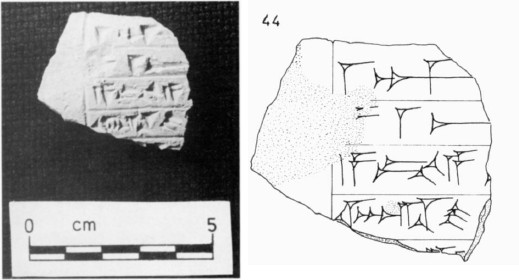
IM - (HW 0044). Elaboration from Black, Iraq 51 pp. 44-46 and pl. III
For an overview of the clay cones belonging to Shalmaneser III's
reign, and their "Types," see the Introduction to this king.
Eleven clay cone fragments (representing at least five clay cone
exemplars) were discovered at Tell al-Hawa, a large mound northwest of
Nineveh. The reconstructed text records the works performed at the
temple of Adad, also mentioning that a forefather (giving no name) originally built it.
For other clay cone fragments from this site see textx nos. 1005-1006.
Access the composite text [http://oracc.museum.upenn.edu/riao/Q004646/] of Shalmaneser III 41.
Bibliography
42
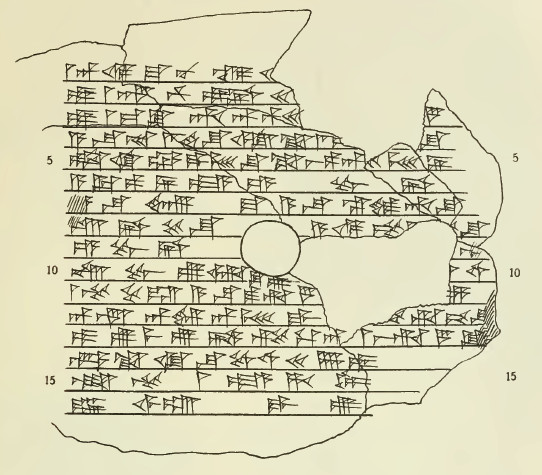
Ist EŞEM 06750. KAH 1 no. 28
For an overview of the clay cones belonging to Shalmaneser III's
reign, and their "Types," see the Introduction
to this king.
The present text belong to the Type A, concerning the work on wall and
gates of the city of Ashur. After the concluding blessing, the text
gives the eponym date of Iaḫalu (833 BC).
Access the composite text [http://oracc.museum.upenn.edu/riao/Q004647/] of Shalmaneser III 42.
Bibliography
43
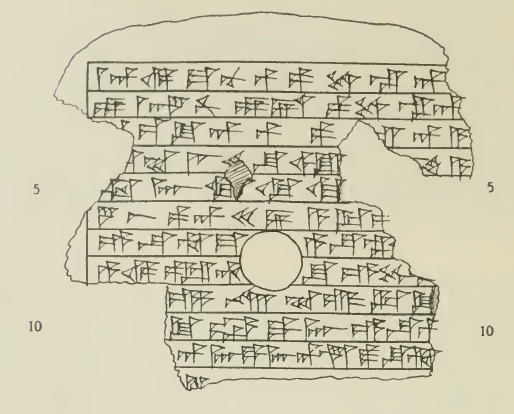
Ist A 03359, Ist A 03349?, Ass 01378. KAH 1 no. 26
For an overview of the clay cones belonging to Shalmaneser III's
reign, and their "Types," see the Introduction
to this king.
The present text is of the type "B," and describes the restoration
works on walls and inner and outer gates of the city Ashur. After the
concluding blessings, the text is dated with the eponym of
Nergal-mudammiq (834 BC).
Access the composite text [http://oracc.museum.upenn.edu/riao/Q004648/] of Shalmaneser III 43.
Bibliography
44
For an overview of the clay cones belonging to Shalmaneser III's
reign, and their "Types," see the Introduction
to this king.
The type of the present text is "C," and records the works for the
restoration of the city walls and city gates of Ashur. As shown below,
this text has many exemplars and many more other fragments could
belong to the same inscription model. Two of such exemplars (exs. 6
and 27) are dated
to the twenty-third regnal year (836 BC); of the remaining twenty-five
exemplars, eight (exs. 1, 3-5, 8-10, 12) have clearly no date, whereas
the others are too broken to guess.
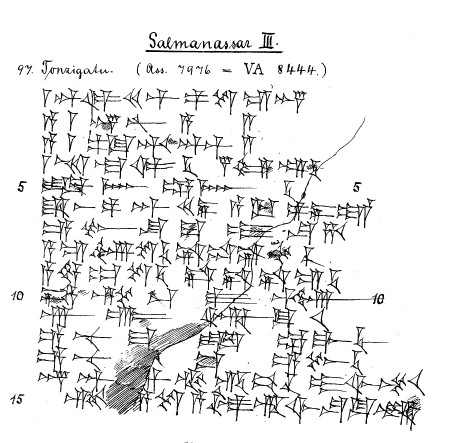
VA 08444. KAH 2 no. 97
Notable in this inscription is the use of Assyrian dialect forms: išdu/ušdu for ištu (l. 8); ussešu for uššešu (l. 8); rubāu urkû for rubû arkû (l. 10); ennuḫūma for ennaḫūma (l. 12); išammeū for išemmû(l. 14).
Access the composite text [http://oracc.museum.upenn.edu/riao/Q004649/] of Shalmaneser III 44.
Uncertain Fragments
(101) Ist A 03347 (Ass 01376) (102) Ist A 03350 (Ass 01379c) (103) Ist A 03357 (Ass 01379(d)) (104) Ist A 03351 (Ass 01379g) (105) Ist A 03360 (Ass 01425) (106) Ist A 03393 (Ass 03828) (107) Ist A 03404 (Ass 04478) (108) Ist A 03408 (Ass 04656a + Ass 04656b + Ass 04656) (109) Ist A 03409 (Ass 04705) (110) Ist A 03410 (Ass 04734b) (111) VA Ass 02108 (Ass 05357b) (112) VA Ass 02109 (Ass 05357b) (113) VA Ass 02112 (Ass 05595) (114) VA Ass 02113 (Ass 05631) (115) Ist A 03428 (Ass 05821) (116) Ist A 03432 (Ass 05926) (117) Ist A 03443 (Ass 06357) (118) Ist A 03445 (Ass 06445) (119) Ist A 03459 (Ass 07282) (120) Ist A 03464 (Ass 07557) (121) Ist A 03466 (Ass 07597) (122) VA Ass 02115 (Ass 07938) (123) VA Ass 02028 (Ass 07980) (124) Ist A 03470 (Ass 08101) (125) VA Ass 02044 (Ass 08389) (126) VA Ass 02039 (Ass 08509) (127) VA Ass 02050 (Ass 09017) (128) VA Ass 02124 (Ass 09326) (129) Ist A 03478 (Ass 10036) (130) Ist A 03479 (Ass 10063) (131) VA Ass 02038 (Ass 10069) (132) Ist A 03481 + Ist A 03482 (Ass 10084b + Ass 10084c + Ass 10084d) (133) Ist A 03484 (Ass 10084f) (134) Ist A 03486 (Ass 10093b) (135) Ist A 03487 (Ass 10093c) (136) VA Ass 02037 (Ass 10093e) (137) VA Ass 02035 (Ass 10093f) (138) VA Ass 02042 (Ass 10093h) (139) Ist A 03488 (Ass 10093i) (140) VA Ass 02034 (Ass 10099a) (141) Ist A 03489 (Ass 10099b) (142) Ist A 03490 (Ass 10101 + Ass 10116m) (143) VA Ass 02041 (Ass 10112c + Ass 10112f) (144) VA Ass 02040 (Ass 10112p) (145) Ist A 03491 (Ass 10119a) (146) VA Ass 02033 (Ass 10099c + Ass 10119b) (147) VA Ass 02046 (Ass 10130) (148) VA Ass 02045 (Ass 10140b) (149) Ist A 03499 (Ass 10238c) (150) Ist A 03500 (Ass 10238d) (151) Ist A 03501 (Ass 10248b) (152) Ist A 03504 (Ass 10255a + Ass 10255b) (153) Ist A 03506 (Ass 10307) (154) Ist A 03507 (Ass 10313) (155) Ist A 03508 (Ass 10318) (156) VA Ass 02126 (Ass 10496) (157) VA Ass 02127 (Ass 10587) (158) VA Ass 02131 (Ass 10794) (159) VA Ass 02136 (Ass 11077b) (160) VA Ass 02043 (Ass 11132a) (161) VA Ass 02047 (Ass 11132b) (162) VA Ass 02137 (Ass 11136b) (163) VA Ass 02032 (Ass 11394) (164) Ist A 03530 (Ass 11606) (165) Ist A 03534 (Ass 11699) (166) Ist A 03535 (Ass 11768) (167) Ist A 03537 (Ass 11912) (168) Ist A 03538 (Ass 11913) (169) Ist A 03540 (Ass 12154) (170) Ist A 03541 (Ass 12155) (171) Ist A 03545 (Ass 12244) (172) Ist A 03546 (Ass 12399) (173) Ist A 03551 (Ass 12761b + Ass 12761g) (174) Ist A 03553 (Ass 12914) (175) Ist A 03568 (Ass 13916) (176) Ist A 03570 (Ass 15178) (177) Ist A 03603 (Ass 18024) (178) VA Ass 02099 (Ass 19416a) (179) VA Ass 02100 (Ass 19416b) (180) VA Ass 02101 (Ass 20959a + Ass 20959b) (181) VA Ass 02268 (Ass 22340) (182) Ist A 03656 (S 209BIS)Bibliography
1. Certain Exemplar
2. Uncertain Fragments
45
From RIMA 3, p. 126: "This is a senselessly garbled version of A.0.102.44 (text no. 44) and not really a different text. It was obviously copied by a scribe who either did not understand what he was doing or did not care. In either case, the fact that there are three exemplars with exactly the same major blunders indicates that a royal scribe did not always copy from a master text. In this instance probably the same scribe copied all of these exemplars, repeating his errors over and over again while adding numerous minor mistakes."
This text is not edited here.
Bibliography
46
For an overview of the clay cones belonging to Shalmaneser III's
reign, and their "Types," see the Introduction
to this king.
A few clay cones and a clay hand from Ashur (see text no. 42). The text describes the Tabira Gate's restoration, and mentions that Aššur-dān II [http://oracc.museum.upenn.edu/riao/thekingdomofassyria1114884bc/ashurdanii/index.html] had previously restored this gate (see introductions to Aššur-dān II [http://oracc.museum.upenn.edu/riao/thekingdomofassyria1114884bc/ashurdanii/index.html] texts no. 3 and 5 and cf. below no. 47). The text is dated to Shalmaneser [http://oracc.museum.upenn.edu/riao/theassyrianempire883745bc/shalmaneseriii/index.html]'s seventeenth regnal year (842 BC). The inscription on the clay hand (ex. 3) contains an abridged version of the text, where Adad-nārāri II [http://oracc.museum.upenn.edu/riao/thekingdomofassyria1114884bc/adadnarariii/index.html]'s name has been omitted from the genealogy, and the inscription was shortened.
Access the composite text [http://oracc.museum.upenn.edu/riao/Q004651/] of Shalmaneser III 46.
Bibliography
47
Two pairs of door sockets bear the following short inscription. They are made of stone and were discovered at the Tabira Gate in Ashur. The four exemplars are exact replicas of each other. The text mentions Aššur-dān II [http://oracc.museum.upenn.edu/riao/thekingdomofassyria1114884bc/ashurdanii/index.html]'s work on the gate (see text no. 46). The placement of Nergal's name directly after that of Aššur indicates Nergal was the protective deity of the gate (see text no. 94).
Access the composite text [http://oracc.museum.upenn.edu/riao/Q004652/] of Shalmaneser III 47.
Bibliography
48
A pair of door sockets bear the following short inscription. They are made of stone and were discovered at the Tabira Gate in Ashur. The two inscriptions are exact duplicates.
Access the composite text [http://oracc.museum.upenn.edu/riao/Q004653/] of Shalmaneser III 48.
Bibliography
49
A large stone block found in the vicinity of the Ištar temple at Ashur bears this brief inscription. The text discusses the rebuilding of the Širrat-nipḫi temple. As stated here, this temple was build earlier by Tukultī-Ninurta I [http://oracc.museum.upenn.edu/riao/thekingdomofassyria13631115bc/tukultininurtai/index.html] (see texts no. 50 and 51).
Access the composite text [http://oracc.museum.upenn.edu/riao/Q004654/] of Shalmaneser III 49.
Bibliography
50
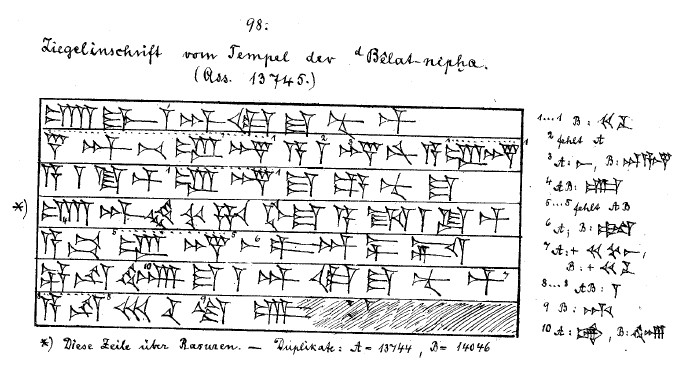
Ass 13745. KAH 2 no. 98
A brick from Ashur (present location unknown). The text commemorates the restoration of the temple of Šarrat-nipḫi. Another text on Ashur bricks (no. 51) is a duplicate except for the royal titles. Regarding the goddess Šarrat-nipḫi and Tukultī-Ninurta I [http://oracc.museum.upenn.edu/riao/thekingdomofassyria13631115bc/tukultininurtai/index.html], who is mentioned to have been an earlier builder see text no. 49.
Access the composite text [http://oracc.museum.upenn.edu/riao/Q004655/] of Shalmaneser III 50.
Bibliography
51
Another text (see text no. 50), on bricks from Ashur, which concerns the reconstruction of Šarrat-nipḫi's temple which had been previously built by Tukultī-Ninurta I [http://oracc.museum.upenn.edu/riao/thekingdomofassyria13631115bc/tukultininurtai/index.html] (see text no. 49).
Access the composite text [http://oracc.museum.upenn.edu/riao/Q004656/] of Shalmaneser III 51.
Bibliography
52
A fragment of clay cone from Ashur (A 3476 = Ass 10012). The text concerns work on the Šarrat-niphi's temple (see text no. 49) and is similar to text no. 51. The inscription has been collated.
Access the composite text [http://oracc.museum.upenn.edu/riao/Q004657/] of Shalmaneser III 52.
Bibliography
53
Two brick fragments from Ashur. The text concerns work on the forecourt of the temple of Aššur. It is identical with brick inscriptions of Adad-nārāri I [http://oracc.museum.upenn.edu/riao/thekingdomofassyria13631115bc/adadnararii/index.html] (RIMA 1 p. 167), save for royal name and genealogy, which have been of course changed. This seems to show that Shalmaneser had discovered Adad-nārāri [http://oracc.museum.upenn.edu/riao/thekingdomofassyria13631115bc/adadnararii/index.html]'s bricks in the course of his reconstruction works.
Access the composite text [http://oracc.museum.upenn.edu/riao/Q004658/] of Shalmaneser III 53.
Bibliography
54
This text is engraved on two pairs of stone thresholds discovered at each side of the doorways to two different rooms in the Anu-Adad temple at Ashur.
Access the composite text [http://oracc.museum.upenn.edu/riao/Q004659/] of Shalmaneser III 54.
Bibliography
55
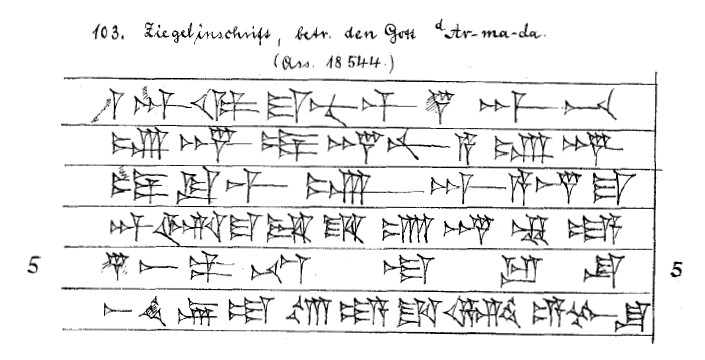
Ass 18544. KAH 2 no. 103
Two inscribed bricks from Ashur. The text indicates the making of the god Armada's gold statue, presumably the patron deity of the city Arwad (see the bibliography given by Michel).
Access the composite text [http://oracc.museum.upenn.edu/riao/Q004660/] of Shalmaneser III 55.
Bibliography
56
Two inscribed bricks from Nimrud. The text concerns the building of Ninurta's ziggurat. Shalmaneser claims to have built this ziggurat for the first time.
Access the composite text [http://oracc.museum.upenn.edu/riao/Q004661/] of Shalmaneser III 56.
Bibliography
57, Fort Shalmaneser's Throne Base (Room T1) - inscription under East Block
One of a few texts written on the throne base of Shalmaneser, found at Fort Shalmaneser. For full details about the throne base, including bibliography, see text no. 28. This text was inscribed under surface of the east block, and is aduplicate of lines 1-6 of text no. 28, and the attestation that the mounment is a donation of Šamaš-bēla-uṣur, governor of Kalḫu, like in text no. 62, belonging to the same monument.
Access the composite text [http://oracc.museum.upenn.edu/riao/Q004662/] of Shalmaneser III 57.
Bibliography
58
A fragmentary text from Shibaniba (Tell Billa), mentions the goddess Ištar. The brick is in the University Museum, Philadelphia (UM 84-26-30) and the inscription has been collated. Regarding a brick discovered at Shibaniba by Layard see text no. 104.
Access the composite text [http://oracc.museum.upenn.edu/riao/Q004663/] of Shalmaneser III 58.
Bibliography
59–62, Fort Shalmaneser's Throne Base (Room T1) - Epigraphs
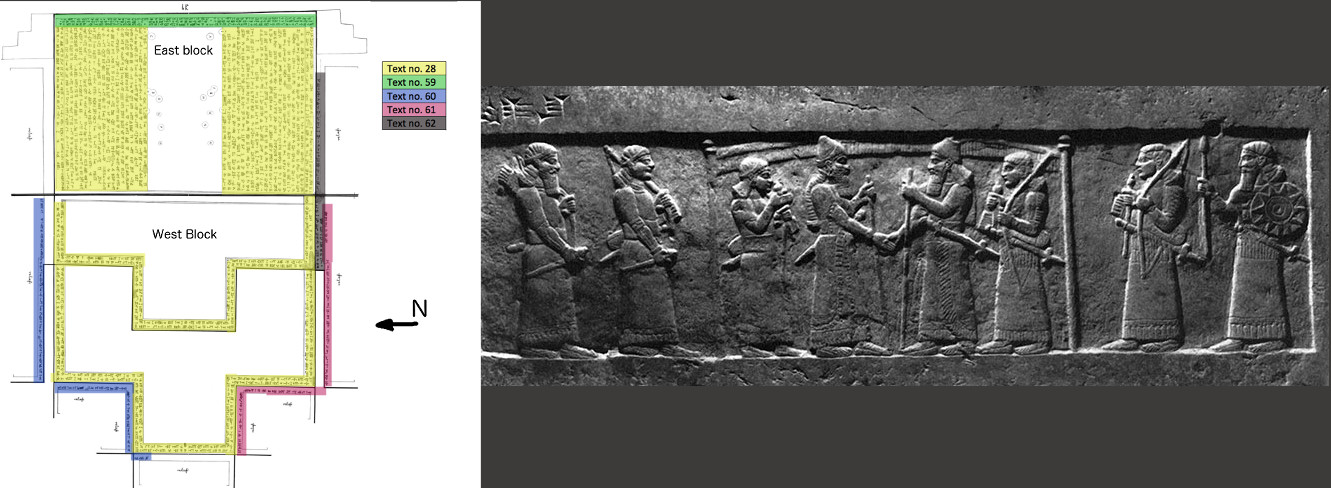
IM 065574. Elaboration from
Hulin 1963 and Iraq Museum's Photo
(Note that the image in teh photo, with Marduk-zākir-šumi (on the left) shaking hands with Shalmaneser, and the present text are not displayed together on the throne base, but one on the very front of it and the other on the rear (in green in the image).
59
One of a few texts written on the throne base of Shalmaneser, found at Fort Shalmaneser. This text is a label to a scene carved on the base's front in which Shalmaneser and Marduk-zākir-šumi are portrayed shaking hands. The text describes Shalmaneser's intervention on Marduk-zākir-šumi's behalf when rebellion had threatened the latter's reign. For full details about the throne base, including bibliography, see text no. 28. The lines are numbered 45-47 as explained there. The abrupt change from third to first person in the text should be noted.
Access the composite text [http://oracc.museum.upenn.edu/riao/Q004664/] of Shalmaneser III 59.
Bibliography
60

IM 065574. Oates and Oates 2001 fig. 110
An epigraph written on Shalmaneser's throne base, found at Fort Shalmaneser. It describes the scene carved below in which Qalparunda is portrayed bringing tribute to Shalmaneser. For full details about the throne base, including bibliography, see text no. 28 (called "line 48" there).
Access the composite text [http://oracc.museum.upenn.edu/riao/Q004665/] of Shalmaneser III 60.
Bibliography
61

IM 065574. Oates and Oates 2001 fig. 110
An epigraph written on Shalmaneser's throne base, found at Fort Shalmaneser. It describes the scene carved below in which Mušallim-Marduk and Adinu are portrayed bringing tribute to Shalmaneser (see text no. 5 vi 6-7 [http://oracc.museum.upenn.edu/riao/Q004610/]). For full details about the throne base, including bibliography, see text no. 28 (called "line 49" there).
Access the composite text [http://oracc.museum.upenn.edu/riao/Q004666/] of Shalmaneser III 61.
Bibliography
62
An epigraph written on Shalmaneser's throne base, found at Fort Shalmaneser. This text indicates the material from which the throne base was made, and also mentions Šamaš-bē1a-uṣur, the official who had installed this throne base. For full details about this object, including bibliography, see text no. 28 (called "line 50" there). Regarding other inscribed objects made by Šamaš-bēla-uṣur see text no. 30.
Access the composite text [http://oracc.museum.upenn.edu/riao/Q004667/] of Shalmaneser III 62.
Bibliography
Nathan Morello, Yehonatan Hershkovitz & Poppy Tushingham
Nathan Morello, Yehonatan Hershkovitz & Poppy Tushingham, 'Inscriptions, texts nos. 40-62', The Royal Inscriptions of Assyria online (RIAo) Project, The RIAo Project, a sub-project of MOCCI, 2020 [http://oracc.museum.upenn.edu/riao/theassyrianempire883745bc/shalmaneseriii/texts4062/]